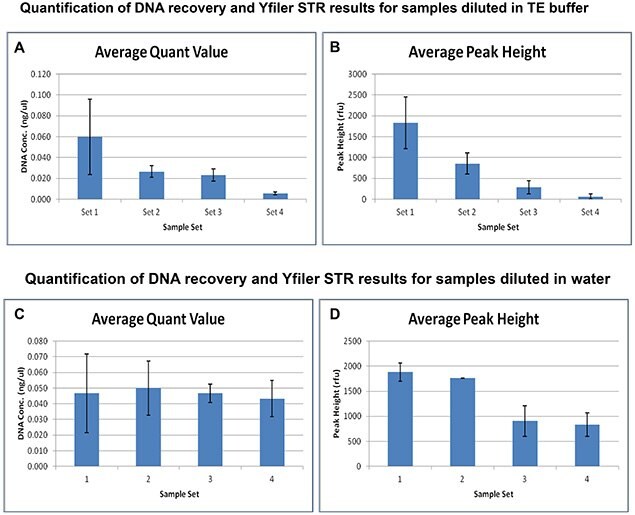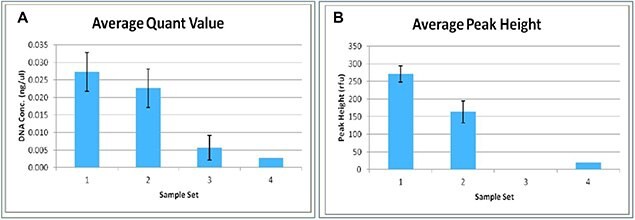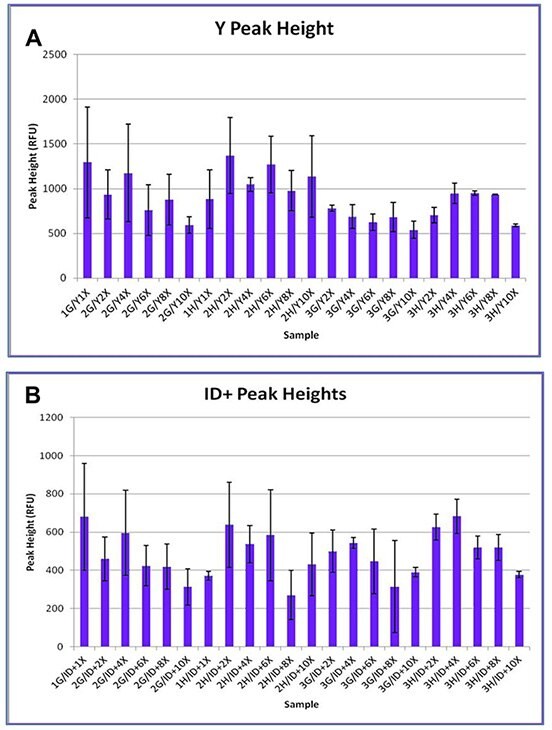A highly efficient method to concentrate DNA for forensic STR genotyping using DNAstable®
Ethan Smith2, Anna Wilson2, Jeremy Sanderson3, Philip Hodge4, Rolf Muller1, Judy Muller-Cohn1, Gary Shutler4
1Biomatrica, 5627 Oberlin Drive, Suite 120, San Diego, CA 92121, 2Washington State Patrol Crime Laboratory, Cheney, WA, 3Washington State Patrol Crime Laboratory, Tacoma, WA, 4Washington State Patrol Crime Laboratory, Standards and Accountability Section, Seattle, WA
Introduction
Forensic laboratories routinely use STR genotyping for identity testing of biological samples. However, forensic samples often contain low copy numbers of target DNA, making it difficult to obtain complete STR profiles. Increasing PCR amplification cycles is commonly performed to address this issue, but it can lead to stochastic effects that call into question the accuracy of the data analysis. To overcome this challenge, forensic scientists use a variety of techniques to concentrate samples in an attempt to increase the total amount of DNA available for amplification prior to the PCR step. These techniques include centrifugal filtration, sample dry-down and re-suspension, as well as precipitation with ethanol and polyethylene glycol. Such concentrating techniques have a variety of drawbacks, with the most critical being sample loss. We describe a technique for easily and effectively concentrating DNA from forensic samples using the commercially available reagent, DNAstable®. This method minimizes sample loss. We provide a case study from the Washington State Patrol Crime Laboratory, which has successfully used DNAstable to concentrate DNA for STR analysis. We show that this technique avoids many of the drawbacks associated with other DNA concentration strategies while providing accurate STR analysis results.
Methods & Materials
Preparation and Quantitation of DNA Samples DNA from eight reference swabs (Samples A - H) was extracted using a Biorobot® EZ1®. (Qiagen). Samples A - C and G - H were eluted in low T10mME0.1mM buffer, (pH 8.0) and samples D - F were eluted in deionized water. All samples were immediately stored in a -20ºC freezer. Additionally, all sample extracts were quantified using the Quantifiler® Human DNA Quantification Kit (Life Technologies/Applied Biosystems) using a 7500 Real-Time PCR System (Life Technologies/Applied Biosystems).
Experiment 1
The purpose of the first part of this study was to examine differences in DNA recovery between Microcon® (Millipore) microfiltration and Vacufuge® (Eppendorf) vacuum centrifugation methods when DNAstable® (Biomatrica) is or is not incorporated. The AmpflSTR® Yfiler® Amplification kit (Life Technologies) was used to demonstrate any differences in recovery.
Experiment 2
The second part of this study sought to determine if increases in TE concentration would lead to inhibition during amplification and used the AmpflSTR® Identifiler® Plus Amplification kit (Life Technologies) as a detector.
Experiment 3
The third part of this study examined the effect of increasing concentrations of DNAstable on downstream applications using both amplification kits.
Amplification of Extracts
Ten microliters from each set was amplified using the AmpflSTR Identifiler® Plus and/or AmpflSTR Yfiler Amplification kits (Applied Biosystems) using a final reaction volume of 25 µL. Amplification was performed on the 9700 Thermocycler (Life Technologies/Applied Biosystems). Fragment analysis was performed on the 3130 Genetic Analyzer (Applied Biosystems) with a five second injection time. Experiment 1 samples were amplified using only the AmpflSTR Yfiler Amplification kit. Experiment 2 and 3 samples were amplified using only the AmpflSTR Identifiler Plus Amplification kit.
Results

Figure 1. Impact of DNAstable on DNA recovery quant values and Yfiler STR peak heights in samples in TE buffer or water.
Set 1: Microcon ultrafiltration with DNA sample containing DNAstable. Set 2: Vacufuge vacuum centrifugation with DNA sample containing DNAstable. Set 3: Microcon ultrafiltration without DNAstable. Set 4: Vacufuge vacuum centrifugation without DNAstable. A. Average DNA recovery of samples in TE Buffer. B. Average peak heights of samples in TE buffer. C. Average DNA recovery of samples in water. D. Average peak heights of samples in water.

Figure 2. Effect of various TE buffer concentrations on DNA recovery quant values and peak heights in DNA samples with or without DNAstable.
Set 1: 20 µL DNAstable in 5X TE. Set 2: 20 µL DNAstable in 10X TE. Set 3: No DNAstable in 5X TE. Set 4: No DNAstable in 10X TE. A. Average DNA recovery after dry down using Vacufuge vacuum centrifugation. B. Average Identifiler Plus STR peak heights after dry down using Vacufuge vacuum centrifugation.

Figure 3. Effect of increasing concentrations of DNAstable on peak heights using either AmpflSTR Yfiler Amplification kit or AmpflSTR Identifiler Plus Amplification kit.
Each tube contained 0.6 ng DNA. Reference sample G & H were DNA eluted in TE buffer during purification. Set 1 was the control with 1X DNAstable in TE buffer. Set 2 contained increasing concentrations of DNAstable from 2X to 10X. Set 3 contained increasing concentrations of DNAstable from 2X to 10X, and were dried and reconstituted in water. A. Peak heights determined using AmpflSTR Yfiler Amplification kit, B. Peak heights determined using AmpflSTR Identifiler Plus Amplification kit.
Conclusions
The process of concentrating DNA to obtain more accurate and interpretable STR profiles warrants careful examination. Based on our results, the presence of DNAstable is beneficial when concentrating via vacuum centrifugation or using a microfiltration device. However, when TE approaches 10X, then a desalting method such as using a Microcon ultrafiltration device should be considered. This holds true for both AmpFlSTR Identifiler Plus and AmpFlSTR YFiler amplification kits. With the issues that can arise from low levels of DNA, the use of optimal concentration methods needs to be carefully assessed to ensure the greatest chance of generating an accurate and robust profile.
如要继续阅读,请登录或创建帐户。
暂无帐户?